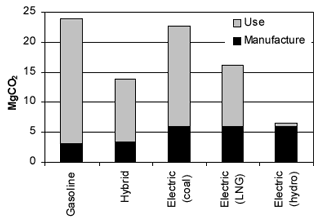 Automobiles: Electric vs. GasolineInstitute for Lifecycle Environmental Assessment: Seikei University (Tokyo), 2001 It is well-known that electric vehicles produce almost no pollution on the road, but how much environmental impact can be attributed to their full life-cycle, including manufacture? And when all of these emissions are taken into account, are electrics really all that much better than gasoline automobiles? And what about hybrid gasoline-electrics? Kiyotaka Tahara and several of his colleagues at Seikei University in Tokyo recently published a study attempting to answer these questions. Unlike the other Life Cycle Assessment (LCA) reviewed in this issue, this work is based on a "bottom-up" method of life-cycle assessment. Tahara et al did not rely on averaged data, but instead carefully catalogued the energy use and CO2 emissions of the various steps in a particular manufacturing process. This allowed them to make precise assessments of changes in energy consumption that would result from changes in altering only those parts of the automobile that determine whether it is electric or gasoline, leaving the body, interior, tires etc. unchanged. This ensures a fair comparison between the gasoline, electric and hybrid models.
Gasoline and hybrid automobiles both use gasoline (or a similar fossil fuel) for all of their energy during the use phase, so it is easy to make an accurate estimate of what the car's total energy (and therefore CO2) inventory will be. But because the use energy of a car is so much higher than the manufacturing energy, the source of an electric car's electricity will have an enormous influence on the automobile's environmental impact over its lifetime. In the United States, for instance, states with large coal reserves (e.g. Pennsylvania, West Virginia) have "dirty" electricity because it is generated mostly with coal, whereas electricity in other parts of the country is cleaner (e.g., the Northwest, where electricity is mostly hydroelectric). The published article focused on CO2 emissions only, which are closely correlated to energy consumption. Figure 1 shows the CO2 emissions attributable to the life-cycle of the gasoline and hybrid models, and to the electric model under three different assumptions about the electricity source. Coal is the most CO2 -intensive form of electric generation, and hydroelectric the least. The method in between these two, liquified natural gas, is more common in Japan (the authors' country) than in the U.S., but is comparable to the direct natural gas firing that is common in the U.S., and is generally considered the cleanest fossil fuel-based method of electricity generation. Figure 1 reveals that gasoline cars are responsible for the least CO2 emissions during manufacture, but the most during use, and therefore the most over the vehicle's total lifetime. Hybrid cars demand slightly higher CO2 emissions during manufacture and electric cars the most. Electric cars' high emissions during manufacture are most likely related to their very large batteries. But certainly the most important lesson of this LCA is the importance of the source of electricity used to power an electric car. Coal-based electricity leads to CO2 emissions nearly as high as for a gasoline-powered car! Yet hydropower results in dramatically lower CO2 emissions. If you want to make an impact on CO2 emissions with your next car purchase, you need to know how the electricity in your region is generated before making your choice. And if in doubt, the best advice is once again to go hybrid. The full citation for the work described here is: Tahara, Kiyotaka et al, "Comparison of CO2 Emissions from Alternative and Conventional Vehicles." World Resources Review v.13 n.1 (2001), pp. 52-60. |
Email this page to a friend
If you speak another language fluently and you liked this page, make
a contribution by translating
it! For additional translations check out FreeTranslation.com
(Voor vertaling van Engels tot Nederlands)
(For oversettelse fra Engelsk til Norsk)
(Для дополнительных
переводов проверяют
FreeTranslation.com )


 Figure 1 - Total carbon
dioxide emissions over the lifetimes of gasoline, hybrid, and electric cars.
The electric car is shown three times, with differing use energies depending on
the method of generating electricity: coal, liquified natural gas, or
hydroelectric.
Figure 1 - Total carbon
dioxide emissions over the lifetimes of gasoline, hybrid, and electric cars.
The electric car is shown three times, with differing use energies depending on
the method of generating electricity: coal, liquified natural gas, or
hydroelectric.